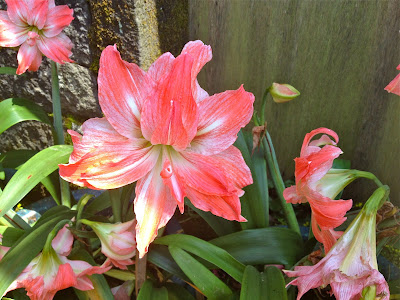Not feeling like exerting ourselves too much (it's been a stressful few weeks) but wanting badly to get out of Taipei City on a sunny weekend day - those are rare enough as it is - we took a fun and relaxing day trip to Sanzhi (三芝) on the northeast coast. Until today I'd known it mainly as the place that my Taiwanese biking friends like to go (I don't bike but I have a few local friends and acquaintances who are really into it) for the countryside outside of town and the cherry blossoms that don't attract as many crowds as the ones closer to Yangmingshan.
It does, however, have plenty to entertain the non-biking day-tripper, and has some good places to bike if you're into that sort of thing. Unfortunately, you need your own transportation to get around most of the most interesting parts, or do what we did and go as a group of 4 and arrange a taxi (NT$500 for the shell temple and puppetry museum; pay the driver a bit more if you want to stroll around the lovely village where the puppetry museum is located and eat or have coffee there). With 4 people this is a pretty reasonable price for chartered transportation. I'll pay NT$200 to not have to drive!
In this post I'll post a few pictures from Lee Denghui's (or Teng-hui if you wish) birthplace and the shell temple, and later on I'll post a few from the puppetry museum and surrounding artsy village.
Let's face it, the most developed/urbanized part of town is kind of bland and ugly, but most buses from Danshui - leaving every 20 minutes - will take you to the "visitor's center and gallery" from where you can arrange a taxi. The gallery isn't much but Lee Denghui's birthplace - an old three-sided farmhouse style brick building - is out back and worth a quick look.
 |
| My sister outside Lee Denghui's birthplace |
 |
| The area around the old house is not as well-maintained and has some current residents, along with their dog (above) and pants (below). |
The road up is extremely steep and not really one I'd recommend trying on foot or on bike if you aren't very fit, but if you can get a ride up there it would be a perfectly fine walk down, with lovely farmland scenery and views out to the ocean on the way down. Bring water and a hat. Or, if you have your own transportation, make it a leisurely drive - you may want to stop and take short walks to enjoy the scenery. It's easy to get carsick - I did - so bring some Green Oil, White Flower Oil or Tiger Balm.
The best way to introduce it is to show you the best of my (iPhone) pictures - so here you go:
Basic provisions are available at the temple (some sold as offerings, some you can buy to eat or drink), and to enter the back corridor you have to pray (just grab some incense, light it and bow a few times in front of the altar before sticking the incense in the pot behind you - no biggie). There are stores on either side, one selling religious items and the other selling super tacky - but also kind of super fun - "handmade" shell souvenirs. I totally bought a soap dish, because I needed a soap dish.
From there you can head down to the puppetry museum and artsy village area - which I'll post about in an hour or two.
Continue reading
here























































